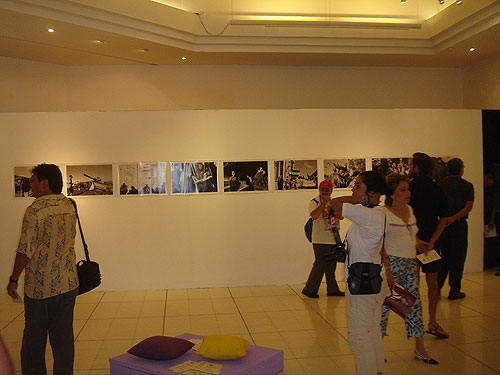 The biennale InteractivA 05 took place for the third consecutive time in Mérida, Yucatán, Mexico. Raúl Ferrera Balanquet was the executive curator; Lucrezia Cippitelli and Gita Hashemi were the invited curators. Artists from different countries participated contributing works that included installations as well as Internet projects (for a complete list of artists, please see the InteractivA 05 website). This was by far the most ambitious and best organized InteractivA, yet. The biennale not only consisted of an exhibition in three major galleries of the Centro Cultural Olympo in Downtown Mérida, but it also included a series of conferences which took place over nine days, from July 16--25. The biennale InteractivA 05 took place for the third consecutive time in Mérida, Yucatán, Mexico. Raúl Ferrera Balanquet was the executive curator; Lucrezia Cippitelli and Gita Hashemi were the invited curators. Artists from different countries participated contributing works that included installations as well as Internet projects (for a complete list of artists, please see the InteractivA 05 website). This was by far the most ambitious and best organized InteractivA, yet. The biennale not only consisted of an exhibition in three major galleries of the Centro Cultural Olympo in Downtown Mérida, but it also included a series of conferences which took place over nine days, from July 16--25.
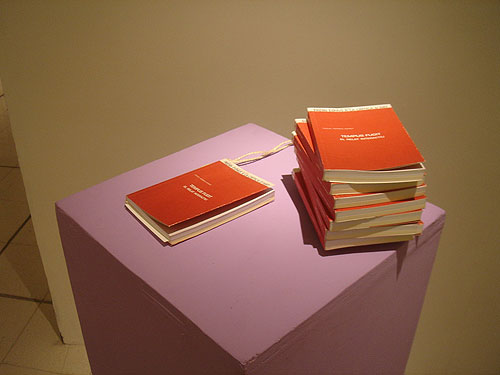 Opening night was well attended. It took place on a Thursday evening, when the town was thriving with energy. The three galleries presented work ranging from video installations, online projects, photo installations and book and magazine installations. The inclusion of print publications was quite interesting because visitors were able to view texts that normally are available only in bookstores and news stands. They were quite successfully placed in the same context as visual work. Raquel Herrera Ferrer's (Barcelona, Spain) Tempus Fugit [related online blog] and Monica Mayer's (D.F. Mexico) Rosas Chillantes were presented on pedestals, while magazines by the collective Bulbo (Tijuana, Mexico) and the collective Guestroom (London, U.K.) were presented as independent installations. It is not possible to go over every single artwork here but it can be said that what became obvious throughout the exhibition was a diversity of works that made it impossible to categorize the exhibition reductively. To learn more about the artworks and to view some of them, please visit the InteractivA 05 website. Given the ephemeral condition of conferences and performances, I will focus on these events for the rest of this text followed by a critical analysis of the curatorial premise. Opening night was well attended. It took place on a Thursday evening, when the town was thriving with energy. The three galleries presented work ranging from video installations, online projects, photo installations and book and magazine installations. The inclusion of print publications was quite interesting because visitors were able to view texts that normally are available only in bookstores and news stands. They were quite successfully placed in the same context as visual work. Raquel Herrera Ferrer's (Barcelona, Spain) Tempus Fugit [related online blog] and Monica Mayer's (D.F. Mexico) Rosas Chillantes were presented on pedestals, while magazines by the collective Bulbo (Tijuana, Mexico) and the collective Guestroom (London, U.K.) were presented as independent installations. It is not possible to go over every single artwork here but it can be said that what became obvious throughout the exhibition was a diversity of works that made it impossible to categorize the exhibition reductively. To learn more about the artworks and to view some of them, please visit the InteractivA 05 website. Given the ephemeral condition of conferences and performances, I will focus on these events for the rest of this text followed by a critical analysis of the curatorial premise.
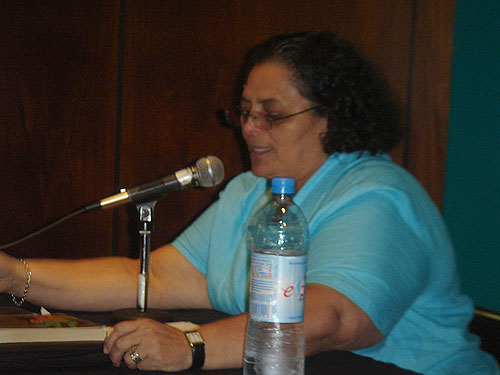 The events included conference presentations as well as live performances. Maria Luisa Molina López (Mexico) presented on the history of the border between Mexico and the United States, the repercussions of Chicanismo on Mexican culture and vice versa, and the role of feminism as a powerful tool towards a real autonomy--a "radical individualism." She reflected upon technology's role as an important element in the ongoing history of these cultures. She left us with open questions on the role of hybridity today. The events included conference presentations as well as live performances. Maria Luisa Molina López (Mexico) presented on the history of the border between Mexico and the United States, the repercussions of Chicanismo on Mexican culture and vice versa, and the role of feminism as a powerful tool towards a real autonomy--a "radical individualism." She reflected upon technology's role as an important element in the ongoing history of these cultures. She left us with open questions on the role of hybridity today.
Gita Hashemi (Iran/Canada) discussed the implications and problematics of entering the mainstream as an artist (something she is not interested in doing)--she is more interested in creating spaces for activism. Considering alternative forms for exhibition as part of such practice is also a subject of her interest. Currently, she is critical of the role of the United States in the middle-east as an imperial power. In relation to this during a second conference with members from Guestroom, Hashemi explained how she develops alternative publications, something she found herself doing more out of necessity to stay active as an artist/curator/writer.
Hashemi along with Raul Ferrera Balanquet (Cuba, Mexico, U. S.) considered eight ruptures moving towards a "post-tecnological" future, which include "interactivity" as an intersection between humans and the ecosystem, "connectivity" as an form of communication exposing the fallacy of the digital divide and central networks, "interdisciplinarity" meaning the relationship of disciplines as a variable perspective, "conceptualization" that is the effects of ideas on what is deemed political and natural, "nomadism" as a way of marking new movements of constant action but also as a space for new types of artforms, "spirituality" meaning the belief that art can be very effective when it is embraced along with multiple realities of diverse cultural mythologies, and "ruptural transformation" meaning a state of constant change in close relationship to nature.
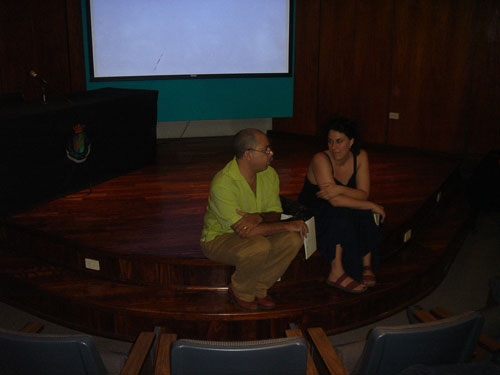 Invited curator Lucrezia Cippitelli (Italy) in her first screening presented a series of experimental videos from various artists in Italy, which can be downloaded from the web. The videos ranged from playful to heavy social commentary. Some questions she brought up were on virtual spaces versus real spaces, do people who make videos have real spaces? And how is the web changing the idea of a space in relation to video? She also presented the work of Otolab during a special screening. This work consisted of software used by Djs and VJs that created visuals meant to be experienced along with music in a very specific settting of a dark room with four walls, which was, unfortunately not available at InteractivA, so an image of overlapped animations was projected on a single wall. The work consisted of abstract red and orange shapes that developed on the fly reacting to the sound that played along during the presentation. She also curated in one of the galleries an installation of a set of abstract videos following the aesthetic of software art, which in this case created images that appear to be random shapes, but structured with specific algorithms; they were presented in DVD format, which made the viewer wonder how a linear narrative can appropriate the aesthetics of digital media. Cippitelli, by presenting works in these different contexts, asks the viewer to reconsider how time-based media is understood differently as a gallery installation, as part of a screening, or as downloadable files available on the Internet. Invited curator Lucrezia Cippitelli (Italy) in her first screening presented a series of experimental videos from various artists in Italy, which can be downloaded from the web. The videos ranged from playful to heavy social commentary. Some questions she brought up were on virtual spaces versus real spaces, do people who make videos have real spaces? And how is the web changing the idea of a space in relation to video? She also presented the work of Otolab during a special screening. This work consisted of software used by Djs and VJs that created visuals meant to be experienced along with music in a very specific settting of a dark room with four walls, which was, unfortunately not available at InteractivA, so an image of overlapped animations was projected on a single wall. The work consisted of abstract red and orange shapes that developed on the fly reacting to the sound that played along during the presentation. She also curated in one of the galleries an installation of a set of abstract videos following the aesthetic of software art, which in this case created images that appear to be random shapes, but structured with specific algorithms; they were presented in DVD format, which made the viewer wonder how a linear narrative can appropriate the aesthetics of digital media. Cippitelli, by presenting works in these different contexts, asks the viewer to reconsider how time-based media is understood differently as a gallery installation, as part of a screening, or as downloadable files available on the Internet.
Pages 1, 2, 3, 4
|
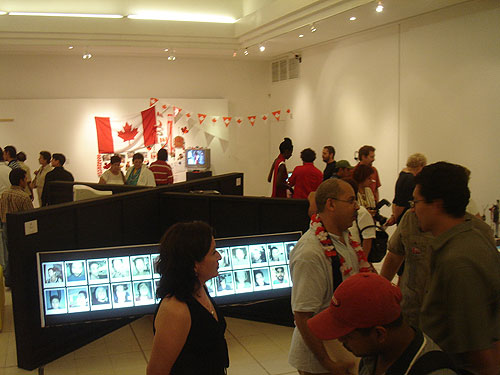 La biennale InteractivA 05 se llevó acabo por la tercera vez consecutiva en la ciudad de Mérida, Yucatán, Mexico. Raúl Ferrera Balanquet fue el curador ejecutivo; Lucrecia Cippitelli and Gita Hashemi fueron las curadoras invitadas. Artistas de diferentes paises participaron contribuyendo instalaciones en galerias y trabajos en la Internet (para una lista de artistas completa por favor visite el sitio en red de InteractivA 05). InteractivA 05 fué definitivamente el biennale mas organizado hasta ahora. Este no solo consistió de una exhibición en tres galerias grandes del Centro Cultural Olympo en el centro de Mérida, pero tambien incluyó una serie de conferencias, las cuales tomaron lugar durante nueve dias, del 16-25 de Julio. La biennale InteractivA 05 se llevó acabo por la tercera vez consecutiva en la ciudad de Mérida, Yucatán, Mexico. Raúl Ferrera Balanquet fue el curador ejecutivo; Lucrecia Cippitelli and Gita Hashemi fueron las curadoras invitadas. Artistas de diferentes paises participaron contribuyendo instalaciones en galerias y trabajos en la Internet (para una lista de artistas completa por favor visite el sitio en red de InteractivA 05). InteractivA 05 fué definitivamente el biennale mas organizado hasta ahora. Este no solo consistió de una exhibición en tres galerias grandes del Centro Cultural Olympo en el centro de Mérida, pero tambien incluyó una serie de conferencias, las cuales tomaron lugar durante nueve dias, del 16-25 de Julio.
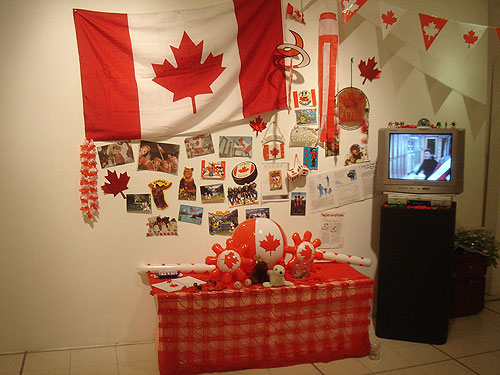 La apertura fue un exito. Se llevo acabo durante un Jueves por la noche cuando la ciudad resplandecia con energia. Las tres galerias presentaron trabajo que incluyó instalaciones de video, fotos, trabajos en la red y publicaciones en imprenta. El incluir pubicaciones en imprenta fue interesante porque el publico disfrutó textos que normalmente solo se encuentran en librerias or tiendas de periodicos; estas fueron presentadas de una manera exitosa en conjunto con trabajo visual. El libro de Raquel Herrera Ferrer (Barcelona, Spain) Tempus Fugit [sitio en red relacionado] y Rosas Chillantes de Monica Mayer (D.F., México) fueron presentados en pedestales, mientras las revistas del collectivo Bulbo (Tijuana, México) y el collectivo Guestroom (London, U.K.) fueron presentados en instalaciones independientes. No es posible describir todas las contribuciones en InteractivA, pero halgo que se puede comentar es que fué obvio en la exhibición que los trabajos fueron muy diversos, los cuales no pueden ser categorisados de una manera simple. Para aprender mas sobre los trabajos y ver algunos de ellos, por favor visite el sitio en red de InteractivA 05. Ya que las conferencias y las performances tienen un elemento efímero, me enfocaré en estas por el resto de este texto, complementandolas con un analysis crítico sobre el tesis de la curadoría. La apertura fue un exito. Se llevo acabo durante un Jueves por la noche cuando la ciudad resplandecia con energia. Las tres galerias presentaron trabajo que incluyó instalaciones de video, fotos, trabajos en la red y publicaciones en imprenta. El incluir pubicaciones en imprenta fue interesante porque el publico disfrutó textos que normalmente solo se encuentran en librerias or tiendas de periodicos; estas fueron presentadas de una manera exitosa en conjunto con trabajo visual. El libro de Raquel Herrera Ferrer (Barcelona, Spain) Tempus Fugit [sitio en red relacionado] y Rosas Chillantes de Monica Mayer (D.F., México) fueron presentados en pedestales, mientras las revistas del collectivo Bulbo (Tijuana, México) y el collectivo Guestroom (London, U.K.) fueron presentados en instalaciones independientes. No es posible describir todas las contribuciones en InteractivA, pero halgo que se puede comentar es que fué obvio en la exhibición que los trabajos fueron muy diversos, los cuales no pueden ser categorisados de una manera simple. Para aprender mas sobre los trabajos y ver algunos de ellos, por favor visite el sitio en red de InteractivA 05. Ya que las conferencias y las performances tienen un elemento efímero, me enfocaré en estas por el resto de este texto, complementandolas con un analysis crítico sobre el tesis de la curadoría.
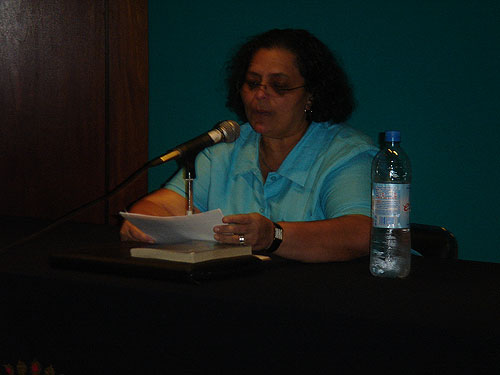 Los eventos incluyeron conferencias y acciones plásticas. Maria Luisa Molina López (Mexico) presentó sobre la historia de la frontera de México y Estados Unidos. El Chicanismo y su relación a la cultura Mexicana y vice versa fue el enfoque principal de su lectura. La influencia del femenismo como una herramienta cultural de gran poder hacia una autonomía real--"individualismo radical," fué también un tema central. Ella reflecionó sobre el lugar de la tecnología como un elemento importante en la historia de las dos culturas. López nos dejó con preguntas habiertas sobre el potencial de la hibrididad hoy en dia. Los eventos incluyeron conferencias y acciones plásticas. Maria Luisa Molina López (Mexico) presentó sobre la historia de la frontera de México y Estados Unidos. El Chicanismo y su relación a la cultura Mexicana y vice versa fue el enfoque principal de su lectura. La influencia del femenismo como una herramienta cultural de gran poder hacia una autonomía real--"individualismo radical," fué también un tema central. Ella reflecionó sobre el lugar de la tecnología como un elemento importante en la historia de las dos culturas. López nos dejó con preguntas habiertas sobre el potencial de la hibrididad hoy en dia.
Gita Hashemi (Iran/Canadá) presentó sobre las implicaciones y problemas quel artista encuentra al entrar a circulos principales en la cultura (Halgo lo cual ella no está interesada en hacer). Hashemi está más interesada en crear espacios para el activismo. Espacios alternativos para exhibir arte son el sujeto de su interes. En este momento, ella critica como los Estados Unidos se impone en el medio-oriente como un poder imperial. En relación a esto, durante una segunda presentación con miembros de Guestroom, Hashemi explicó como ella desarrolla espacios alternativos de publicación, halgo que ella se encontró haciendo para mantenerse activa como artista/curadora/escritora.
Hashemi junto con Raul Ferrera Balanquet (Cuba/mexico/U.S.) consideraron varias rupturas moviendose hacia un futuro "post-tecnologico," las cuales incluyen "interactividad" como una intersección entre los humanos y el systema ecológico, "Conectividad" como una forma de comunicación la cual expone la falsedad de las division digital y las redes centristas, "interdisciplinaridad" o sea la relación entre disciplinas con una perspectiva variable, "conceptualización" en relación a los efectos de ideas sobre lo que se considera politico y natural, "nomadismo" como una forma de marquar nuevos movimientos en constante acción pero también como un espacio para nuevas formas de arte, "Espiritualidad" o la creencia que el arte puede ser eficaz cuando se incorpora entre realidades multiples de mitologías de diversas culturas, y "rupturas transformativas" o el estado de cambio constante con una relación cerca a la naturaleza.
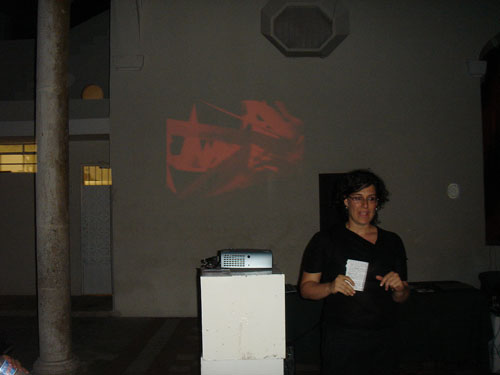 La curadora invitada Lucrezia Cippitelli (Italia) en su primera presentación mostró una serie de videos experimentales de varios artistas Italianos. Los videos trataron temas sociales con comentarios humoristicos y serios; estos pueden ser descargados de la red. Una preguntas que ella propuso fueron sobre espacios virtuales contra espacios reales ¿Tienen la gente que hace videos espacios reales? ¿Como está la red cambiando la idea del espacio en relación al video? Tambien presentó trabajo de Otolab durante una segunda noche. Este trabajo consistió de un software que es usado por Djs y Vjs. La presentación consistió de imagenes abstractas en rojo y anaranjado las cuales son vistas con en acompañamiento de musica en un cuarto oscuro de cuatro paredes, pero esta instalación no fue posible en InteractivA. Así que Cippitelli presentó una imagen sobrelapada proyectada sobre la pared. Las imagenes son producidas en el momento, de acuerdo a el sonido. También ella seleccionó una serie de videos abstractos los cuales siguen la estética del software art. En este caso las imagenes aparecian ser figuras aleatóricas, pero estructuradas con un algoritmo especifico. Los videos fueron presentados en formato de DVD, el cual hace que el publico questione como la narrativa linear se appropea de la estética de los medios digitales. Cippitelli, al presentar estos trabajos en situaciones diferentes, le pregunta al publico que reconsidere como los medios narrativos que dependen del languaje del cine son entendidos en una instalación de galleria, como una presentación en sala de cine, y como material en la Internet listo para ser descargado. La curadora invitada Lucrezia Cippitelli (Italia) en su primera presentación mostró una serie de videos experimentales de varios artistas Italianos. Los videos trataron temas sociales con comentarios humoristicos y serios; estos pueden ser descargados de la red. Una preguntas que ella propuso fueron sobre espacios virtuales contra espacios reales ¿Tienen la gente que hace videos espacios reales? ¿Como está la red cambiando la idea del espacio en relación al video? Tambien presentó trabajo de Otolab durante una segunda noche. Este trabajo consistió de un software que es usado por Djs y Vjs. La presentación consistió de imagenes abstractas en rojo y anaranjado las cuales son vistas con en acompañamiento de musica en un cuarto oscuro de cuatro paredes, pero esta instalación no fue posible en InteractivA. Así que Cippitelli presentó una imagen sobrelapada proyectada sobre la pared. Las imagenes son producidas en el momento, de acuerdo a el sonido. También ella seleccionó una serie de videos abstractos los cuales siguen la estética del software art. En este caso las imagenes aparecian ser figuras aleatóricas, pero estructuradas con un algoritmo especifico. Los videos fueron presentados en formato de DVD, el cual hace que el publico questione como la narrativa linear se appropea de la estética de los medios digitales. Cippitelli, al presentar estos trabajos en situaciones diferentes, le pregunta al publico que reconsidere como los medios narrativos que dependen del languaje del cine son entendidos en una instalación de galleria, como una presentación en sala de cine, y como material en la Internet listo para ser descargado.
Pages 1, 2, 3, 4
|
![]()